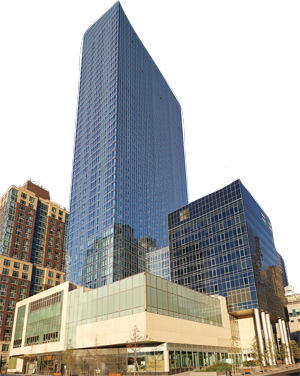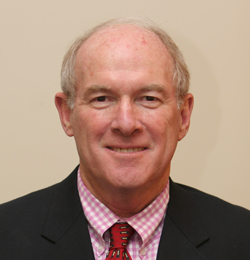Trending
Battered but not beaten
Following the retirement of its founder and a series of setbacks, is the Dermot Company finding its stride again?

When the Dermot Company’s [TRDataCustom] founder, Bill Dickey, retired in June 2015, the firm’s latest and largest project to date was an incomplete structure hovering 30 stories above the ground.
The planned 48-story, 750,000-square-foot Upper West Side rental tower 21 West End — which is slated for completion in January — wasn’t only ambitious in scale. It signaled the firm’s push toward ground-up luxury rental high-rises, or as Dermot CEO Stephen Benjamin called it, “lifestyle renting.”
The Midtown West-based real estate firm is now looking to make more-substantive changes, redefining its role as an investor and developer of rental housing. Through the purchase and construction of larger properties, the firm is vying to become a rental development giant like the Brodsky Organization or Glenwood Management. But the shift has been far from seamless.
In the past two years, executives at Dermot backed out of two major projects that would have ranked among its most ambitious: a Hudson Yards rental-condo on a Port Authority site and the landmarked Battery Maritime Building in Lower Manhattan. Both projects ultimately proved far costlier than expected.
Dermot’s embarrassments at Hudson Yards and in Battery Park City, deals where it won requests for proposals, and a strategy that has seemed all over the map, should not, however, be taken as an indication of disorder at the firm, sources say. Rather it is the result of a shift from a largely singular vision to multiple ones. And, sources say, it says a lot about Dermot’s resiliency that the firm has managed to take those setbacks in stride without tempering its ambition or appetite for risk.
After Dickey retired, investors joined forces to buy him out of the company that he founded in 1991, and two longtime execs, Drew Spitler and Andrew Levison, joined Benjamin as partners. Then London-based fund Forum Partners and San Francisco-based real estate magnate and Golden State Warriors co-owner Dennis Wong’s SPI Holdings, neither of which had much experience in the New York market, took a combined 50 percent stake in the company.
One of the first moves the new partnership made was to replace Dermot’s prewar rent-stabilized holdings with bigger rental buildings that were better suited for a repositioning and rent hikes.
 By the early 2010s, Dermot had amassed 5,000 rent-stabilized apartments in a portfolio worth more than $2 billion. The partners sold Dermot’s extensive portfolio of older, rent-stabilized housing — 32 buildings across three boroughs — to Douglas Eisenberg’s A&E Real Estate for about $360 million.
By the early 2010s, Dermot had amassed 5,000 rent-stabilized apartments in a portfolio worth more than $2 billion. The partners sold Dermot’s extensive portfolio of older, rent-stabilized housing — 32 buildings across three boroughs — to Douglas Eisenberg’s A&E Real Estate for about $360 million.
The firm kept some 3,000 apartments — most of which it had developed — and is now worth $1.5 billion, about three-fourths of its previous value.
“When Bill turned 70 a few years ago, he said to me, ‘I want to wind down, so let’s make a plan,’” Benjamin, 48, noted.
“It wasn’t to go to the kids,” he added, referring to Dickey’s two daughters, who are not in real estate. “It wasn’t to be sold off and dissolved. He really gave us the chance to keep going.”
Forum Partners CEO Russell Platt, meanwhile, noted: “Those markets that Dermot is active in are always in transition, so it’s never an ideal time to undergo a generational shift.”
Bold beginnings
Dickey started his career as a high-powered New York real estate lawyer at Cravath, Swain & Moore in the 1970s and ’80s in the vein of “a Lenny Boxer or a Jonathan Mechanic,” one source said. He then worked at the investment bank First Boston Corporation, now known as Credit Suisse First Boston, eventually spearheading its real estate finance and brokerage division.
In the wake of the savings and loan crisis, he left New York for California to start his own company in 1991. He named the Dermot Company after his father, Dermot, an Irish immigrant postal worker. For much of the 1990s, Dickey bought apartment buildings in Colorado, Arizona and Georgia. But he was bored with West Coast living and missed New York.

21 West End
He returned to the Big Apple in 1999 and two years later hired two principals — Stephen Benjamin and Andrew MacArthur — to help shift his business to the city. In New York, he wanted not only to buy buildings, as he had in Colorado and Arizona, but to develop them as well.
Benjamin, who had been working on the development side of Security Capital Group, which after multiple acquisitions was bought by AvalonBay Communities and Equity Residential, became a key part of enacting that plan. Also key was the money that Dickey had amassed from his rental empire.
“A lot of the initial boost came from him having seed capital,” said Brad Dubeck, the commercial real estate banking executive for New York and New Jersey at Bank of America.
With the pieces in place, Dermot, in partnership with an affiliate of Iowa-based Principal Financial Group, aggressively scooped up thousands of rent-stabilized apartments in the working-class neighborhoods of Brooklyn, Queens and the Bronx.
The tenants of the buildings they acquired were not always happy with their new landlords, however, and by the mid-2000s, Dermot had a mixed reputation as a building owner.
“They were buying occupied rent-regulated buildings at an overleveraged price and driving out the low-rent-paying tenants,” one executive at a nonprofit housing group said on the condition of anonymity.
Then MacArthur, who had been leading the multifamily push, left Dermot in 2007, shortly after his divorce from Dickey’s daughter. A former employee described MacArthur’s exit as “a difficult unwinding” during which the partners bought him out and Benjamin and Spitler took on bigger roles. MacArthur, who later oversaw the management of Stuyvesant Town-Peter Cooper Village as an executive at CWCapital Asset Management and now runs his own investment firm, Brooksville Company, declined to comment.
By the late 2000s, Dermot had established itself in two areas: developing ground-up, primarily 80/20 rentals, and buying and renovating rent-stabilized buildings. Those projects included a two-tower Hell’s Kitchen complex and the Opal in Kew Gardens Hills.
After the downturn, Dermot followed through with a string of new development projects — the 326-unit rental at 66 Rockwell Place in Downtown Brooklyn, the 346-unit rental Moda in Jamaica, Queens, and the 78-unit rental Arabella in the East Village.
But the company’s latest, 21 West End, is the closest yet to a true luxury building, despite its 80/20 status. The SLCE Architects-designed Upper West Side property is loaded with amenities, from multiple club rooms and lounges to an indoor dog run and a playroom with a climbable 2-ton dinosaur. ICRAVE conceived of the amenities.

Rendering of 21 West End’s playroom (credit: ICRAVE)
The 616-unit building is part of the sprawling, eight-acre Riverside Center site on which GID Development and Silverstein Properties are each developing their own projects. Dermot is slated to wrap construction on 21 West End by early next year, though tenants have already started moving in. Market-rate rents at the property start at $3,400 per month for a studio. And since leasing launched in August, about 15 percent of the market-rate units have landed tenants.
“These buildings are a little more experiential,” Benjamin said of the company’s shift to luxury rentals.
Renter concessions
It hasn’t been the best time to make that shift, however. Benjamin said Dermot offers an average of two months of free rent to tenants at its buildings as an incentive in a slowing luxury rental market.
The Carlyle Group, which along with Extell Development sold the lot to Dermot, opted to retain a roughly 30 percent stake in the project. (The AFL-CIO Building Investment Trust is Dermot’s primary equity partner on the project.)
The project marks Dermot’s last ground-up venture for the next couple years. Amid the market slowdown and uncertainty over Donald Trump’s looming presidency, Benjamin said he expects Dermot to make only two acquisitions a year and one ground-up project in the next few years.
The company remains focused on New York, despite the recent involvement of Forum Partners’ Platt and SPI’s Wong. All of Dermot’s assets outside New York were sold off in the 2000s. Platt advises the executives on raising capital, while Wong has led a recent building acquisition: the Eastland, a 23-story, 209-unit Kips Bay rental, from Equity Residential for $173 million in February.
In addition to the Eastland deal, Dermot made another value-add purchase this year: a 13-story, 130-unit East Village rental at 250 East Houston Street in partnership with Rockwood Capital for $100 million in October. Dermot is planning to invest about $20 million in renovations at each of the buildings and then raise rents. Both the Kips Bay and East Village buildings are much bigger than the low-rise multifamily walkups Dermot made its bones buying up and represent the type of value-add buys it hopes to make in the future.
There are rumors, however, that Dermot may be considering a bigger change: outsourcing property management. Sources told The Real Deal that Wong, despite visiting New York only once a month and not being involved in day-to-day operations, is dissatisfied with the property management side. He is reportedly looking to bring in an outside, national manager like Greystar, which is now managing the Eastland, for other Dermot buildings.
Wong declined to comment, and Benjamin denied the allegations.
“We’re working cooperatively with Greystar on the management at the Eastland,” Benjamin said. “We’re not a national management company. If someone wants that perspective, we’re not that.”

Bill Dickey
The bulk of Dermot’s roughly 80 employees work in the property management division, Benjamin said. Therefore, the hypothetical outsourcing of property management would be a dramatic shift. Dermot occasionally does third-party management, like managing the 35-story Upper East Side rental tower the Colorado, developed by TIAA. An outsourcing move would free up the firm to devote more resources to other aspects of the business.
And Dermot’s building management practices have attracted controversy in the past. After Dermot took over 250 East Houston Street in October, doormen and maintenance workers were forced to either take a large pay cut or be out of a job, DNAinfo reported. In response, Benjamin said the company “followed all the laws there are” and that third-party manager Planned Building Services provides labor services for the building under Dermot’s ownership.
A review of court documents shows that since 2005, Dermot has been hit with more than 20 lawsuits, almost exclusively from tenants.
In response, Benjamin said, “Thousands of our tenants, the vast majority, have been happy, and we’ve had very few actions over the years.”
R.I.P., RFP
Dermot’s more daring moves have met with less success. Winning bids for city-commissioned projects, the company’s executives embraced opportunities outside their comfort zones. But such risks have not always panned out, and two of these costly, ambitious projects ended up scrapped.
In September, a major EB-5 regional center in the city accused Dermot-affiliated entities of allegedly failing to pay interest on $77 million in loans granted for the Battery Maritime project. Then, last month, the New York City Economic Development Corporation sued the entities for allegedly defaulting on their rent for more than a year. The EDC claims the Dermot execs owe more than $1.2 million.
The company is now facing foreclosure, the latest obstacle in a decade-long debacle over the planned redevelopment of the iconic building at 10 South Street. Dermot executives Benjamin and Dickey won the Bloomberg administration bid in 2006 to construct a $150 million hotel addition to the existing building.
“We were getting ready for construction in 2012 when Hurricane Sandy hit,” Benjamin said. “Sandy destroyed the project and caused a greater than 12-month delay. The delay, coupled with the costs of construction going up significantly, made the original project budget just unsuccessful. Two years ago, we started discussions with EB-5 to refinance and restructure it with the city. I’m hoping a deal is finalized so we can step out.”
Now Dermot is close to finalizing a deal to hand the project over to developer Steve Witkoff, Benjamin said.
Another city-commissioned project that the company won would have been its tallest, at 55 stories. But in 2014, Dermot scrapped plans for a 500,000-square-foot condo-and-rental tower on a Port Authority-owned site in the emerging Hudson Yards neighborhood. The firm had signed a contract to pay as much as $175 million for the site. Yet the tower would have had to cantilever over part of Dyer Avenue, adding unforeseen costs.
“I’d like to have a piece of Hudson Yards, but the costs simply have gotten too high,” Dickey, 73, told TRD. “I thought it was a good site, but not a great one.”
The Port Authority has yet to announce a new developer, although it received city approval last year for an SLCE-designed nine-story apartment building on the site.
“Pulling out of a project before you’ve invested in it can sometimes be the best thing you can do,” Benjamin said.
It is unclear how these missteps will affect the company’s RFP track record going forward.
In the past, however, Dermot’s relationship with risk has reaped rewards and may well do so again. In the late 2000s, for example, it plowed forward with the construction of 66 Rockwell Place when a flurry of other projects stalled.
“It took some guts given what was going on in the world,” said Bleecker Seaman, co-CEO of Lowe Enterprises Investors, which partnered with Dermot on the project.
For now, Dermot says it’s looking for value-add acquisitions, but the firm has shown itself unafraid when it comes to making hypercompetitive bids for top-shelf multifamily buildings. This year, Dermot bid on Kips Bay Court, an eight-building, 894-unit complex. Blackstone Group, which famously paid $5.3 billion for Stuyvesant Town-Peter Cooper Village with Ivanhoe Cambridge last year, ultimately entered contract in August to buy it for $620 million. That deal is poised to be the city’s largest multifamily trade of the year.
“They want to be one of the huge multifamily sponsors in New York,” said Drew Fletcher of the Greystone Bassuk Group, which has brokered several financings on behalf of Dermot. “That’s their goal.”
One source said the trio of new executives — Benjamin, Spitler and Levison — are more like “cowboys and hustlers, eager to make a name for themselves.”
Benjamin was always more interested in development than Dickey, the two admitted, and that is likely to drive the direction of the company in the future along with its appetite for risk.
“We will build more buildings than before because I like to build,” Benjamin said. “But not everything works out. The Battery Maritime project didn’t work out. All our investments take a long time. Even though the rental market is hard to be in right now because of the economics, we’re sticking to our knitting.”




